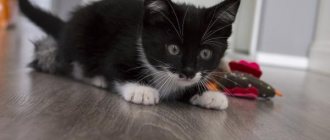Love for all living things is inherent in man by nature itself. Some people cannot pass by a homeless puppy, while others prefer to have exotic animals at home or keep an aquarium. There are people who love cats. The psychology of those who are not indifferent to felines also has its own characteristics. After all, the conscious choice of a four-legged friend can tell a lot about the character of its owner. As the famous writer M. Twain said, cats differ from other pets in that they cannot be forced to obey by any means. These animals will never become slaves. And under no circumstances will cats do anything they don’t want to do.
People who love cats
The psychology of dogs, unlike meowing animals, is simple and understandable. They quickly learn to follow commands and are easy to train. Maybe this is why ardent cat lovers prefer the wayward character of a cat. She is independent and stubborn. The cat prefers to walk by itself, as was noted in the famous work of R. Kipling. But, despite this, she is able to truly become attached to a person. And, having become his friend not involuntarily, but of his own free will, he can fall in love sincerely and forever.
When we have a cat in our home, we automatically strive to communicate with wild nature. In essence, it is a small tiger that you can pick up and pet. Mostly women prefer furry pets, but it happens that men also love cats. Our psychology is structured in such a way that sooner or later we all strive to create a family and a cozy hearth. And purring is a symbol of home well-being, calmness and reliability. A soft creature curled up in a ball, purring peacefully on the sofa, gives a feeling of warmth and a stable way of life. Love for a cat often characterizes a man as an exemplary family man, a caring father. Such a person appreciates comfort in the home, feminine affection, order and cleanliness, and a delicious lunch. If a guy prefers cats to dogs, then he will look for a life partner to match. Bright, beautiful, graceful and independent. But at the same time, affectionate, tender and able to give love.
Man - friend or feeding slave
Even the most affectionate, sweet and gentle pet can at any moment wag its tail and leave a person, stopping communication with him for a while.
Unlike devoted dogs, who are ready to follow their owner everywhere with inexhaustible love, cats prefer to maintain independence and a bit of disdain in their relationships with humans.
Features of the relationship between cats and people:
- According to the research of anthrozoologist John Bradshaw, the cat perceives a person as a “brother-in-law,” only a very large and safe one.
- The owner’s “lisping” with the cat, “intimate” conversations with him or addressing him as a small child, and not as an animal - all this is a desire to endow a cute pet with qualities characteristic of a person.
- Although cats have been kept as pets by people for a long time, they are not as close to their owners as dogs. This is due to the peculiarities of the period of their domestication. When taming dogs, a person communicated with him on equal terms, because the task was to make the dog understand them. With cats it's a different story. A person needed them to protect his house from mice. Cats lived next to people, but at the same time they existed as if in a parallel world.
- For the mustachioed and striped people, man is not the center of the world. No matter how gentle and affectionate a pet may be, you should not expect bright manifestations of feelings and the same reciprocal love from him. Cats live their own lives, occasionally allowing close contact with people, and only when they want it.
- When a cat brings a caught mouse into the house, many owners are touched, believing that the pet wants to share a meal with them. However, the purr is not capable of such “generous” actions. He simply brought his prey to a quiet place where no one would lay claim to it.
- The cat demonstrates its disposition towards the person and the desire to receive affection and attention from him accordingly - he begins to rub against the owner’s legs and expose his head, tilting it to the side, so that he can be scratched behind the ear. The cat will behave the same way towards its fellow tribesmen.
When placing high hopes on your pet, expecting absolute obedience and good behavior from him, you should remember that a person is not the cat’s owner, but only his big “neighbor” who feeds and cares for him.
Choosing a pet and awareness of responsibility
The psychology of cats is so unique that raising them requires a special approach. When you decide to have this semi-wild animal in your home, you need to remember the great responsibility. After all, this is not a hamster that will live only a few years. When getting a cat, you should realize that it will become its owner’s companion for the rest of its life. You will have to put up with her behavior, with fur on all surfaces, including clothes and food. Moreover, this pleasure is not cheap. The animal needs nutritious food and care, it can get sick. And then you will have to spend a lot on veterinarian services. But if all these worries don’t scare you, then you belong to the category of people called “cat lovers.” Your psychology is designed in such a way that any pet’s whims will be perceived as little pranks. And communication with him will give only positive emotions and fill you with a good mood.
Nanny cats
Cats love to sleep in beds with babies because they smell like mother's milk. It is possible that cats also like a soft and cozy baby bed. Of course, you should not allow a cat to be in bed with a baby: it is not hygienic. In addition, the animal may accidentally scratch the child.
Cats are very kind and caring towards small children.
When the baby grows up, there is no need to limit his communication with the soft fluffy ball. Young children love cats because they are interested in an animal that is active and loves to play and jump. Some children love to pet cats, subconsciously perceiving them as their mother - gentle and affectionate. Young children may not always be able to clearly understand and explain their feelings of frustration, resentment, or fatigue. But those children who have a furry pet in the house endure stress much easier. You can pet the cat and listen to its purring, after which you will feel calm and peaceful.
Some cats are very kind and caring towards small children, show them their love in every possible way and try to spend a lot of time together. Parents from an early age should teach their child to communicate correctly with a cat, then this friendship will bring a lot of positive emotions for all family members.
Character and temperament of cats
Cats live by instinct. German scientists have discovered an interesting pattern. It turned out that the psychology of cats is determined by their color. Striped animals are more independent; they are very reluctant to make contact with humans. They prefer to be left to their own devices. Black cats, on the contrary, are sociable and love affection. White felines are monogamous. They become attached to only one owner, giving him all their attention, allowing only him to stroke them. But black and white ones are usually harmless, they adore children, allowing them to cuddle them. Tricolors and reds are somewhat phlegmatic, a little odd, and slow. But these statements are not an axiom and do not always correspond to reality. The psychology of cats, the character and characteristics of their behavior also depend on what type of temperament the animal belongs to from birth. And as they grow older, other qualities are added to this base. There are four such types:
- Sanguine. This cat quickly gets used to a new environment and loves children. She gets along easily with other pets, is mobile and moderately active.
- Choleric. The psychology of cats and cats of this type is characterized by vigorous activity. Their mood changes quickly, they are quick-tempered and somewhat nervous, meow loudly and growl. The pet will not tolerate resentment or hold back emotions. He will prefer to immediately fight back with his paw or bite his opponent. Be it a human or another animal. You never know in advance what to expect from him. It is more interesting for such a cat to live with an owner who leads an active lifestyle and has an explosive temperament. In a house where there are small children, you need to keep an eye out for choleric cats. A child may unknowingly pull his tail or press his paw, for which he will receive a rebuff.
- Phlegmatic person. This is a calm, slightly slow and calm cat. She rarely shows emotions, is reserved and very reserved. She may sleep around the clock or watch listlessly as attempts are made to engage her in play. This cat will appeal to homebodies, elderly or busy people who are rarely at home.
- Melancholic. This is a very sensitive and touchy animal. You can’t yell at him, much less physically punish him. Cats are shy, afraid of strangers or new interior items. The psychology of melancholic cats is characterized by great devotion and love for humans. But they choose only one owner, who becomes their friend, because they are monogamous.
Knowing the characteristics of temperament will help you choose the right pet, because the beginnings of distinctive features are clearly visible already at a very young age. Character is revealed in the process of communication with brothers and sisters, with the mother cat. It is enough just to observe the behavior and play of the baby to understand what his character is.
Interesting facts about the psychology and behavior of cats
Cats are unique creatures, but sometimes people find their behavior strange and funny:
- Each cat has his own preferences regarding the appearance of the female. One male may be completely indifferent when he sees a tortoiseshell or red cat near him, and show intense interest when he meets a black cat.
- Many cats at shows get very nervous because of the large number of people and unfamiliar surroundings. These nerves manifest themselves in constant tail twitching. This is easy to deal with - the owner pinches the tip of the tail with his fingers, returning it to a static position, and the cat immediately calms down. The effect is triggered - there is no opportunity to show your nervousness - which means there is no nervousness itself.
- Cats have a sense of humor, but a “peculiar” one. Their favorite pastime is to quietly get close to another cat and scare him with his sudden appearance.
Relationships between dogs and cats
The relationship between these completely different animals is well described in the work of K. Lorenz “A Man Finds a Friend.” A book that reveals the psychology of cats and dogs from all sides should definitely become a reference book. Especially if a person plans to have these pets at home at the same time. The author describes in detail life situations from personal experience, gives recommendations and advice. There are a lot of differences between animals. Take, for example, body language, a considerable part of which is given to the tail. A dog wagging its tail shows joy, greeting, and readiness to make contact. And the nervous twitching of a cat's tail signals displeasure and irritation. The first meeting of seemingly irreconcilable enemies is the most important. Depending on how it goes, further animal relationships will be built. But friendship can arise between them, especially if you accustom them to each other from a very early age. Even if a connection has been established and the pets are already sleeping and playing together, this does not mean that they should have everything in common. Each of them needs their own personal space, a separate corner with a bowl for food, as well as an equal amount of attention from the owner. Purrs are more prone to territorial aggression, this is how the psychology of cats works.
The book also describes how best to accustom animals to living together in order to traumatize the psyche of both as little as possible. It is believed that bringing a cat into a house with an already living dog is the most favorable situation. After all, dogs worry less about their territory and are more obedient, if, of course, they are raised correctly. It has also been observed that larger dog breeds bond more quickly with a small kitten. Animals that fall in love with each other begin to look after each other, sleep together, and eat from the same bowl.
How to make friends with a cat?
The easiest way to make friends with a cat is at an early age, because the kitten perceives the person who feeds, cares and caresses it as its mother. Over time, the owner and kitten “get used to” each other, they develop joint fun and traditions. If an adult cat for some reason dislikes a person, she will not want to spend time with him and will refuse to accept his attention. In such cases, you can try to make friends with the cat, although this process is long and will require patience from you.
- Try to create the most comfortable conditions for the animal: a cozy bed, good food, periodic treats, interesting toys.
- Do not perform actions that the animal may perceive as an act of aggression: do not shout, do not make sharp hand gestures, do not create noise and a nervous environment in the house, do not throw the cat during games.
- Cats can remember an insult for a long time and, on occasion, take revenge on the owner, so treat the animal with respect: do not disturb it while sleeping, do not take food, do not scream, and do not hit it under any circumstances.
- Study special literature on the topic of cat sign language. This way you will begin to understand what mood the cat is in and what she wanted to get from you. For example, if you see that the animal has flattened its ears and retracted its head, it is better to leave it alone. And if the cat looks at you intently, blinks and moves towards you, it’s time to pet it.
Cats can remember an insult for a long time and, on occasion, take revenge on their owner.
When the cat understands that you are not a threat to it and are friendly, over time it will begin to trust you.
Advice! If you are unable to make friends with a cat, despite all your efforts, try contacting an animal psychologist or, for example, finding thematic groups of cat lovers on social networks. Experienced breeders will not refuse you useful advice.
What do cat poses say?
It is generally accepted that felines are more liked by straightforward, frank and fair people. Cats, whose psychology is structured differently from dogs, can become their true friends, but not slaves. You can find a common language with a cat if you know the peculiarities of its behavior. You should pay attention to everything: posture, manner of movement, voice, ears and tail. Cats use more than just sounds to express their needs. More often they prefer to communicate using gestures and facial expressions, and sometimes a whole set of signs.
Love for cats, whose psychology has not yet been fully understood by anyone, is an incentive to study the habits of the animal and understand it. A cat's poses are graceful and can tell a lot about her:
- Calm, observation - the cat sits with its tail wrapped around its paws.
- Greeting - the cat rubs against the owner’s legs, moving from paw to paw.
- Love and affection - rubs its muzzle and whiskers against the face or legs of the owner.
- Thoughtful - lying on his back.
- Warning – a sharp swish of the tail.
- Intimidation - the back is arched.
- Threat - fur standing on end, paws straight and outstretched.
A raised cat's tail indicates friendliness; a lowered and tousled tail indicates confusion. A tail pointing down and tapping the floor means the cat is scared. Nervous twitching of the tail from side to side, whipping it on the sides means the highest degree of aggression.
Dominance and the desire to suppress enemy aggression can rarely be observed among females. A mother cat, if her babies are in danger, will fight to the bitter end. She will give her life for the kittens, not retreating even from the most terrible and large enemy. But cats often, in the struggle for the affection of a young cat, can fight fiercely, finding out who is stronger. The pose when they stand motionless, nose to nose, expresses extreme concentration. The slightest movement of the enemy or a sharp extraneous sound can become the impetus for a brave battle. But one of the cats is defeated sooner or later. He lies on his stomach, pressing his body and head tightly to the ground, and extends his paws with claws towards the enemy. His posture expresses both submission and threat. In this case, the winner leaves first, demonstrating his dignity and superiority. Friendly relations between adult males are practically impossible.
The psychology of cat behavior towards humans at home is somewhat different. They rarely express extreme aggression towards their owner. But a stranger may be scratched or bitten if he does not retreat after the warning signs. More often, aggression is triggered by fear, stress or confusion. Complete trust in the owner and others is manifested in a position on the side or back, when the stomach is open. The cat's eyes are usually closed, she is relaxed, dozing and is not at all averse to being petted.
Scientists have explained why people love cats
Why do we love cats so much? There are many versions: from banal toxoplasmosis, a parasitic disease carried by cats and affecting the psyche, to the parental instincts they awaken.
Of course, humanity does not live by cats alone: no less often than ardent cat lovers, you can meet equally radical dog lovers. There are people who feel love for one type of animal, and intense hostility for another.
But cats are more often adopted - and not only because it is easier. Why is this so, the Reedus correspondent looked into it.
Anna Dolgareva // Reedus
Ethological scientists who study animal and human behavior have their own point of view on this issue. They believe that this love is genetically determined. Large cats were among the most dangerous predators for our ancestors. To survive, we needed to track and notice their habits, observe them, and admiration became a by-product of our interest, gaining a foothold in the course of natural selection,” psychologist Maria Plyusnina told Reedus.
According to the expert, people “are fascinated by the grace and harmonious graceful movements, in which the danger that is under our control is easily read.” Konrad Lorenz, an outstanding Austrian zoopsychologist, in his book “Man Finds a Friend” argued that cats, with the exception of a few decorative breeds, “are not domestic animals at all, but truly wild creatures.”
Wild? Maybe.
However, for many, interacting with them is a way to receive and share unconditional, selfless love. The meme about “forty cats” as the choice of a lonely woman in old age is not accidental: if it doesn’t work out to create a couple, then a person can try to escape loneliness in the company of pets.
Anna Dolgareva // Reedus
Many will call this method a surrogate - and, of course, it will not replace a full-fledged family.
However, communication with a finicky, capricious, sometimes gentle, and sometimes biting cat can save you from loneliness - to wait out the “darkest hour.” A person has needs for emotional intimacy, for contact with others and communication, to take care of someone - and pets satisfy these needs to some extent.
Another property of cats is the ability to awaken the parental instinct.
“Ethology, the science of behavior on the verge of biology and psychology, believes that love for cats is a consequence of the parental behavior inherent in us, or rather, even the need for its implementation. We take care of our little brothers, be they cats, puppies, snakes or praying mantises. And in a sense, meowing is mimicry of a child’s cry,” says psychologist Ksenia Shiryaeva.
Anna Dolgareva // Reedus
It turns out that the notorious “forty cats” are a sublimation of unrealized parental instinct. However, there is another version. The fact is that cats are not only cute, fluffy, defenseless animals, but also the embodiment of grace and selfishness. This is what captivates many people.
“This is the age of narcissism. And cats meet the ideal criteria of many - flexible, slender, elegant bastards. Their behavior is in many ways similar to narcissists, provided that we are talking about the average person. That is, humanization is characteristic of man. Humans attribute human reactions and emotions to animals. So, the instinctive behavior of cats is easily humanized into a narcissistic personality. And now it is precisely such people who are in trend - the cult figures of modern cinema successfully prove this,” says psychologist Nina Sergeeva.
Facebook // Tatyana Sertun
There are other versions.
For example, from a biological point of view, human love for cats may be due to fear of an ancient creature, which was hunted by owls and seals (as we know, humanity is also not indifferent to owls).
Over time, humans became smarter and grew larger, while cats, on the contrary, decreased in size (although not all of them). However, the perception of the cat as a part of reality that initially attracts attention, that is, an external stimulus that generates nervous excitement, remains. But the emotion has already become different.
Facebook // Tatyana Sertun
By the way, how do cats themselves perceive us?
Biologist John Bradshaw from Great Britain believes that a cat perceives a person as a big cat - only rather stupid and dependent. Well, like a kitten. That is why purring is used as communication. Kittens begin to purr when they ask their mother not to move away while they suckle.
Adult cats don’t use this method of communication much among themselves, but when they’re around people they purr—maybe that way something will reach the big, stupid bald kitten.
So the parental instinct evoked by cats works both ways.
Conversation with a cat: sounds and facial expressions
Although cats prefer to communicate with gestures, the most talkative of them purr constantly. The cat's tongue contains more than 16 signals of various ranges, including ultrasound, inaccessible to the human ear. Mothers often communicate with their kittens using such inaudible sounds. An ordinary “meow” may differ in timbre and tonality. Having learned to speak like a cat, a person will be able to convey the necessary information to the pet with similar sounds. For example, quietly hissing at a cat when it does something forbidden, you can let it know that it should not be done. The psychology of cats is designed in such a way that not all of them are too talkative. Some animals make only a few quiet sounds throughout their lives. Others, on the contrary, constantly scream, purr, growl, hiss and grumble. Here's what some cat words can tell you about your furry friend's mood:
- Hissing is a warning signal.
- Snorting – surprise, desire to distract the enemy, confusion.
- Low range rumbling – readiness for defense.
- Grunting is a threat and a warning.
- Clattering of teeth, smacking and bleating is a desire to catch prey or disappointment if this was not possible.
- Purring - the cat is happy with life.
- A cooing short “meow” is the joy of meeting, greeting.
- Vibrating with a hoarse “meow” - a friendly attitude, gratitude.
Each drawn-out “mi-auu”, “meaa-u” in most cases expresses a request, a call for help, a complaint or a cry. The degree to which a cat is talkative depends not only on its individual character, but also on its breed. The psychology of Thai cats, as well as their Siamese and Oriental counterparts, is different in that they are very talkative and sociable. British and European shorthair cats, on the contrary, are silent.
The facial expressions of all cats are very expressive due to the high degree of mobility of the muscles of the face and head. A cat's eyes are a mirror that reflects the pet's mood and state of mind. Half-closed eyelids and slow blinking mean calm, tranquility, and relaxation. Wide eyes - interest, concern. Fear is shown by dilated pupils. A narrowed gaze expresses warning and challenge. Sharply constricted pupils indicate extreme concentration. If the cat looks away, then it is ready to obey. A direct look into the eyes of the owner and ears stretched forward express interest, a request, a desire to communicate or eat. Ears drooping to the sides indicate aggression, while ears pulled back and drooping indicate that the cat is scared. If the tips of your ears twitch nervously, this is a sign of insecurity.
Education and training, punishment and reward, play and toys
If a woman or man loves cats, whose psychology is so unpredictable, then, of course, they will want to play with them. Cats are hunters by nature and know how to have fun without a person. Rustle pieces of paper, balls, laces, curtains and other pieces of furniture and interior design are the best toys for them. By running, jumping, trying to catch its own tail, the kitten develops its body and skeleton, strengthens its muscles. When playing with a cat, you should remember that she is used to being dominant. And too aggressive, in her opinion, attacks on the part of the owner can forever discourage the cat’s interest in playing with him. A bow on a string or a lace in her understanding is prey. And the victim cannot behave fearlessly, attack or fight back. The cat should not be allowed to play with its arms and legs. The habit of scratching and biting can easily become ingrained, which is extremely unpleasant and dangerous for young children.
When raising a cat, you need to remember that it will not be possible to train it and achieve complete obedience. She does not care about prohibitions, she does not react to physical punishment, continuing to do what she likes. It is important to teach the animal to relieve itself in a special tray, absorb food and sleep in strictly designated areas. Here all actions should be aimed at developing conditioned reflexes. For example, if a cat gets into the habit of walking past the litter box or to another corner, then he should be purposefully led to that place day after day, waiting for him to do his business. We must not forget about encouragement; the cat needs to be caressed, stroked and praised. After a few days, or at most weeks, the cat will get used to it.
How to tell if a cat loves you
Cats have a unique language with which they “talk” to people. Every owner must learn to understand the mood of their pet so that their connection is strong and mutual. To express sympathy and love, cats have a whole arsenal of facial expressions and gestures:
- Purring.
- Licking.
- The desire to spend all the time together.
- Falling asleep on your knees and in the same bed.
- Showing belly and tail.
- “Butting”, rubbing against arms and legs.
- Sharpening claws on furniture.
- “Massage” with claws and trampling on the body.
- Surprises and gifts.
10 signs a cat loves you
Territory and social aspects of behavior
The psychology of cats is designed in such a way that territory is very important for them, because they are asocial animals. They mark their favorite places, thus protecting their personal space from uninvited enemies. Despite this, in nature cats can live in groups or colonies, gathering according to their interests. For example, feed together, sunbathe in the sun. As a rule, there is no friendly communication between them. Each individual retains its individuality, trying to retire to sleep in a secluded place, choosing separate paths for walking and places for thinking, favorite trees for sharpening claws.
Hunting and food
And although cats are simply amazing hunters, they do not need to hunt at home. Just like they don’t need to protect their homes. The breadwinner and protector is the owner, whom the cat treats more like a parent. This is manifested in the way she shifts from foot to foot, gently rubs her legs, showing her affection. This is exactly how a kitten communicates with its mother. Hunting for a domestic cat is entertainment, an instinctive desire. She can catch a mouse, a fly or a bird. Quite rarely, a cat decides to attack a huge rat with sharp teeth that can cause her pain. The domestic cat brings its prey into the house. This is a gift for the owner, an expression of true friendship and care.
Mother cat and offspring
Cats are very caring and devoted mothers. They constantly lick the kittens, stimulating the babies' blood circulation and breathing. Animals raise their offspring through play and silent communication. If there is a threat of danger, the cat may drag the children to another place. But the connection between mother and child does not last long. As soon as the kitten grows up, the cat loses interest in him, perceiving him as a young male or female.
Regardless of which pet you decide to place next to you, remember that the psychology of cats, dogs and other animals works differently. And, before bringing a new tenant into the house, it would be a good idea to study the main behavioral features of the future pet, so that in the future his pranks, play or aggressive behavior will not become an unpleasant surprise. Once in a new home, the kitten feels defenseless and unsure of itself. He needs someone who will help him get comfortable in a new place, protect him from dangers and become a true senior comrade. And cats never forget kindness, an affectionate attitude, as well as pain and fear. And all these feelings are usually associated with a person. Take care of your cat, caress it, do not hold it by force, do not punish it too harshly, and it will become your faithful friend for many years.











